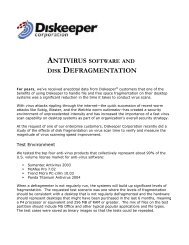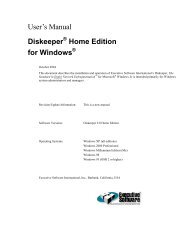Diskeeper 10 User's Manual
Diskeeper 10 User's Manual
Diskeeper 10 User's Manual
Create successful ePaper yourself
Turn your PDF publications into a flip-book with our unique Google optimized e-Paper software.
Answers to Frequently Asked Questions 67<br />
advantage of RAID. In fact, the effects of fragmentation can be more obvious in a RAID array than in a single<br />
disk drive.<br />
<strong>Diskeeper</strong> defragments RAID arrays just as it does single disk drives. <strong>Diskeeper</strong> improves the speed and<br />
performance of a RAID environment by eliminating wasteful and unnecessary I/Os from being issued by the<br />
file system. In our four-drive array example, it would defragment the pieces of the file on each separate drive as<br />
though they were separate files, and as directed by the RAID controller.<br />
Why do I get an incorrect excess fragment count after defragmenting an NTFS<br />
drive under Windows 2000?<br />
Under Windows 2000, NTFS files that have been compressed, then decompressed, accumulate excess space<br />
allocations that <strong>Diskeeper</strong> cannot move. (The defragmentation APIs can only move actual data, not unused<br />
allocated space in the file.)<br />
Microsoft states in knowledge base article Q228198 "Disk Defragmenter Analysis Shows More File Fragments<br />
Than File Size Suggests" that the "excess allocation" is released when the file is closed. Experiments performed<br />
in our labs show that this is not the case. The disk must be dismounted and remounted (or the system rebooted)<br />
followed by an open and a close of the file for the excess allocation to be released.<br />
Therefore, when this condition exists on an NTFS volume, <strong>Diskeeper</strong> moves the data portion of a file, and if the<br />
file has an excess allocation, it can actually fragment the file—one piece being the data just moved, the other<br />
piece being the excess allocation “left behind”. <strong>Diskeeper</strong> notes this properly in its statistics. However,<br />
sometime after the file movement is completed and the file is closed, the excess allocation is released by<br />
Windows 2000. Thus, a subsequent analysis shows the fragmentation figures reported at the end of the<br />
defragmentation run to be wildly wrong.<br />
This excess allocation phenomena was introduced in Windows 2000, but is not present in Windows XP or<br />
Windows Server 2003.<br />
<strong>Diskeeper</strong> engineers are working on a solution for this inconsistency. Until it is found, you can (1) avoid using<br />
NTFS disk compression or (2) perform a subsequent disk analysis to get the correct information.<br />
Does <strong>Diskeeper</strong> support Windows clustering?<br />
<strong>Diskeeper</strong> is certified for Windows clustering. To run <strong>Diskeeper</strong> in a clustered environment, perform the<br />
following steps:<br />
1. On the system that has control of the clustered disk(s), install <strong>Diskeeper</strong> and schedule it.<br />
2. Fail the clustered disks over to the other system, install <strong>Diskeeper</strong> and schedule it.<br />
After you perform these steps, <strong>Diskeeper</strong> will run on the clustered system that remains in operation after the<br />
other clustered system has experienced a system failure. <strong>Diskeeper</strong> will also run on the clustered disk/partition<br />
in an active-active cluster, defragmenting the clustered disk/partition on the system that currently has control of<br />
the disk/partition.<br />
Note: the <strong>Diskeeper</strong> Boot-Time Defragmentation will not run on clustered partitions.<br />
How can I run <strong>Diskeeper</strong> from an account that is not a member of the<br />
Administrators group?<br />
If the account you are using is not a member of the Administrators group, you will not be able to install or<br />
operate <strong>Diskeeper</strong>. We recommend that you simply use the Set and Forget It feature to set a schedule to allow<br />
<strong>Diskeeper</strong> to run in the background on all systems. Since the Set It and Forget It operation runs under the<br />
SYSTEM process, there is no need for an administrator to be logged in when it is running.<br />
Do I need to have the <strong>Diskeeper</strong> service running all the time?<br />
Yes. DkService is the program that actually runs <strong>Diskeeper</strong> defragmentation jobs. It monitors the <strong>Diskeeper</strong><br />
schedule file and starts defragmentation jobs when they are needed. If the <strong>Diskeeper</strong> service is disabled or not<br />
present, you will not be able to run <strong>Diskeeper</strong> at all.






